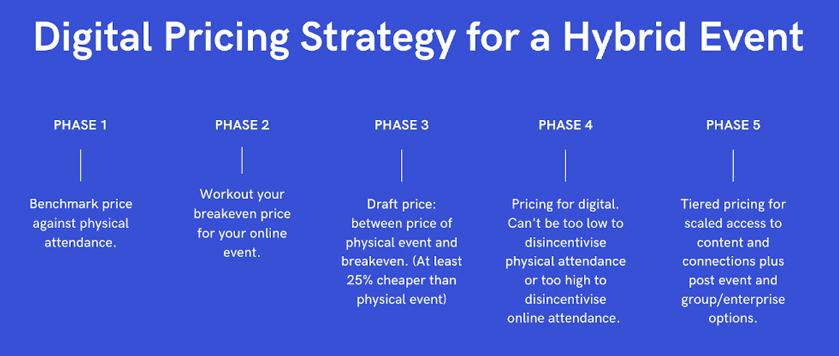Skift Take
Virtual events and event components are here to stay, and learning how to monetize them is essential for the survival and recovery of the industry. How should you price access to these events? What strategies work best?
Answering this question is more complicated than it might at first seem. When we polled the participants of our recent Pivot to Virtual event, almost 75% of respondents said that they do not charge for their virtual events at all. As we move forward, there are practical considerations to keep in mind, but also ethical ones.
From a pragmatic perspective, you have to be able to convince prospective attendees that your event is worth the cost, but it’s important to be sensitive to the unprecedented financial challenges we are all facing, and that means setting a fair price while delivering value for money.
With that said, at the end of the day, you won’t be able to keep providing this value for your clients if you don’t build a sustainable model for your own business. Moreover, you don’t want to undersell the product that you’re offering.
To help you devise a pricing model for your own events, we reviewed four examples that explain the nuts and bolts of different monetization strategies while keeping the bigger picture in mind.
‘Pay-What-You-Can’ Transitioning to Fixed Price
Event: Several Skift Virtual Events
Past model: PWYC, with suggested contributions of $25 and $50
New model: fixed price (typically $50/event for non-subscribers)
The events industry is in the middle of a steep learning curve. The timeline for re-opening is uncertain, and long-term plans are shifting day by day. Under these circumstances, it’s reasonable for event planners to adjust their pricing model as they work to gain a foothold.
The team at Skift settled on a temporary pay-what-you-can system for its virtual events while establishing the value of its virtual offerings, but will transition to fixed-price tickets.
“We know what we do has real value to people working in the travel industry,” explained Chief Product Officer Jason Clampet, “but we also know that companies were making cuts across the board and we had yet to prove our value on these types of events.”
Skift has already begun charging flat ticket rates, with non-subscribers to our Research product recently paying $50 to participate in a webinar. We will likely be introducing the same format for our Skift Airline Weekly product, which also operates under a subscription model.
It’s important to remember that Skift serves one of the hardest hit industries: the travel sector. Skift’s CEO and Founder, Rafat Ali, added that the pay-what-you-can model was initially designed to “give back” to an industry that is witnessing a “near extinction level” crisis, but that a fixed-price policy will soon be necessary to protect the revenue streams for these events and the ability to offer top-notch content. So far, clients seem to agree that these virtual events are worth the cost of admission.
Multi-Tiered Pricing
Event: The Practically Perfect PA Virtual Summit
Individual ticket: £50.00
Group tickets: £250.00
Enterprise ticket: £1,000.00
*Option for VIP upgrades at each price point.
The flexibility of virtual formats can also allow you to set price tiers, in this way ensuring that your event remains affordable while still presenting multiple opportunities for upselling.
William Thomson of Gallus Events explained how the Practically Perfect PA Summit has optimized the pricing structure of its virtual offerings. The following three strategies are key: providing an affordable basic admission price, incentivizing bulk purchases through bundling options, and offering upgrades for additional content access.
For virtual events, your overhead costs are mostly shouldered in the initial development phase for your online platform, and attendee numbers don’t have such a direct impact on your costs. With this business model in mind, a lower admission charge can actually translate to higher profits.
For hybrid events, Thomson suggests setting a virtual admission price that’s at least 25% cheaper than in-person attendance, but still higher than your breakeven cost.

Caption: Image courtesy of William Thomson at Gallus Events.
The Practically Perfect PA Virtual Summit charges £50.00 for individual tickets, but it also has an “enterprise” option that covers 49 participants during the live event and unlimited company access to post-event content. Enterprise tickets are currently set at £1,000.00, but the event expects to raise this rate in future.
With virtual events, you can treat the general cost of admission as an entry point for further content monetization.
Thomson was also keen to emphasize that online content presents multiple avenues for monetization. Practically Perfect PA centralizes all of its training content from previous events on one portal: “We now have hundreds of people from these enterprise tickets accessing their summit training through the online portal, where they can see all of our other training that’s available for an additional fee.”
The Practically Perfect PA Summit even built the principle of upselling right into their pricing structure. “A standard ticket only got you content from the main stage. A VIP ticket got you content from the main stage, all the on-demand content, plus the live master classes.”
Discounted Admission and Flexible Cancellation
Event: Augmented World Expo
Admission: $199 ($399)
Cancellation policy: full refund 1 month in advance and 50% refund 2 weeks in advance
While it’s one thing to set a price point for an event that was initially marketed as a virtual engagement, it’s another to revisit the pricing for an event that only recently pivoted to virtual. If many of your registrants signed on before the transition was made, it might make sense to offer a partial discount or even modify your cancellation policy.
There are many factors to consider here. On the one hand, the overhead costs for virtual events are generally much lower, and there is an argument to be made for transferring some of these potential cost savings to the end buyer. On the other hand, many events that have only recently transitioned may not be able to renege on all of their financial commitments to venues and other suppliers, which may mean that a virtual event pivot is an additional cost with a delicate ROI.
There is also the risk of underselling the value that you’re providing, particularly if you’re able to offer on-demand access to top-rate content and carefully designed opportunities for virtual networking and engagement.
The Augmented World Expo has found a middle ground by charging a discounted rate of $199
(down from an original price of $399) and adopting a more lenient cancellation policy. They’ve also been careful to frame these modifications as an effort to accommodate attendees rather than as a signal of reduced value. In their words, “We understand that the COVID-19 […] outbreak has affected people from around the world in different ways, which is why we’ve improved our refund policy.”
The event landing page also emphasizes opportunities for virtual engagement, through both interactive Q&A sessions with speakers and 1-on-1 video call demos with exhibitors. Much like Practically Perfect PA, they’ve also designed their platform to provide access to exclusive post-event content, available for a full year following the event.
While Augmented World Expo chose to slash their ticket price by 50%, there is an argument to be made for keeping your price consistent. Christopher Gerhart of Crescent Event Productions recently tested this approach; even when attendees were given the opportunity for a full refund after the first day, not a single one cancelled.
While a ‘money back guarantee’ trial offer may not be commonplace in the events industry, the virtual model makes this approach much more financially viable — and it could make a full-price ticket more attractive to potential attendees.
Flat-Rate Exhibitor Fees and Bundled Virtual Trade Show Packages
Event: Toy Fair Everywhere
Exhibitor fee: $650 for three virtual market weeks, or $500 for two (limited to the final two)
Trade shows that build their reputation primarily on traditional buyer-seller interactions might have a harder time positioning virtual events as an attractive replacement for in-person exhibitions. Many buyers might be reluctant to close deals without experiencing products first-hand or having personal interactions with account reps, and spontaneous exploration is a key allure of the showroom floor.
With that said, virtual events are undoubtedly a step above outright cancellation, and they can provide access to a much wider audience of potential buyers. Furthermore, virtual engagement makes it possible to track buyer engagement with a precision that’s simply not possible in person.
The Toy Association has decided to navigate these waters by offering three “market week” events that allow exhibitors to showcase their new products and set up meetings with prospective buyers.
In an April 9th press release, Marian Bossard (Executive VP of Global Market Events) framed the events as a stop-gap measure: “These three virtual market weeks […] were not created to replace our existing face-to-face marketplaces (Toy Fair New York and Toy Fair Dallas) but to supplement them and help bridge the gap in industry engagement.”
Nevertheless, a May 12th press release emphasized their ability “to provide exhibitors with custom experiences and unlimited possibilities to promote their products; leverage real-time analytics; and connect with global buyers – some of whom would not otherwise be able to make the trip to an in-person event.”
All three events are grouped under the Toy Fair Everywhere title, and they span into Q4 (July 13-19, August 17-23 and September 14-20). Toymakers can participate in all three events for a flat rate of $650, or register for August and September only at a rate of $500. These bundling options reflect a strategy that delivers maximal exposure for exhibitors while also accounting for the upfront development costs of the digital platform. The pricing also represents a dramatic reduction in Toy Fair’s standard exhibitor fees, which typically start at $5,100 and can go up to over $27,000.
IN CONCLUSION
Ultimately, the pricing structure that you develop for your event will depend on how well you’ve been able to replicate — and in some cases even enhance — the in-person experience using a digital format.
For some of you, temporarily adopting a “pay what you can” model may be a way to support your clients through a time of crisis. For others, you may choose to offer discounts or more forgiving cancellation policies. The lower cost of hosting events will usually mean that you have a little more leeway to adjust pricing downwards.
Your overhead costs will often be structured around a “flat rate” for event app development costs rather than around attendee numbers. With an almost limitlessly scalable business model, there is every reason to embrace package deals, whether they be in the form of group tickets or bundled events.
While virtual events do present some limitations, in other respects they represent a much more flexible revenue model.








